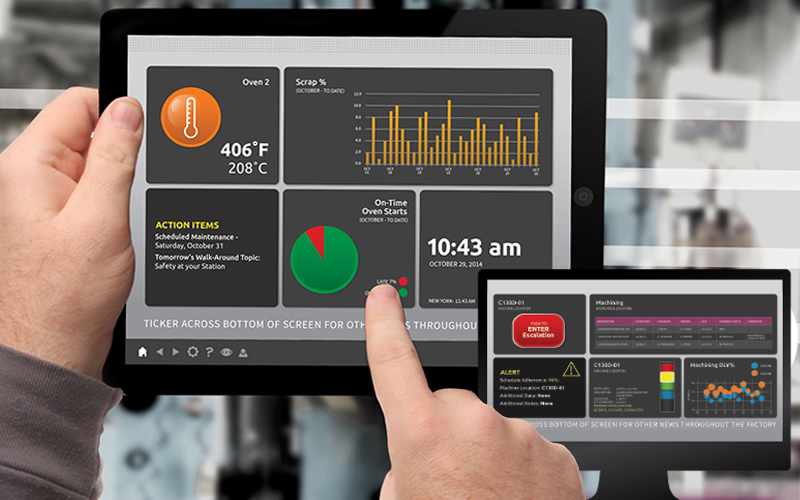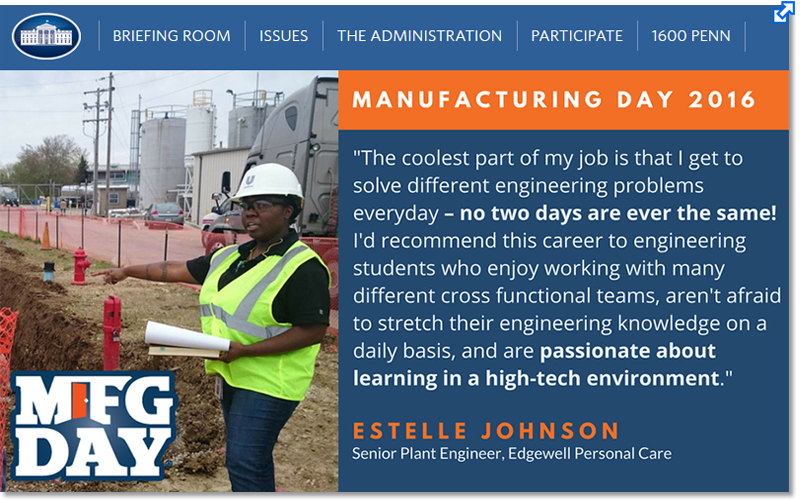MFG Day: How Manufacturing Drives The Economy

Expert panel discusses value of Manufacturing Day, including the downstream sales chain, and how manufacturing accounts for an estimated 33% of GDP and 33% of employment.
To kick off the nationwide celebration of Manufacturing Day today, October 7, an expert panel hosted by the Fabricators & Manufacturers Association, International (FMA) has highlighted the significant role manufacturing plays in bolstering America’s economy and the critical need to ensure that the sector remains a positive force.
Sharing insights at the “How Manufacturing Drives the Economy” program (watch video above) are;
Stephen Gold, president and CEO of the Manufacturers Alliance for Productivity and Innovation;
Scott Mayer, chairman and CEO of QPS Employment Group;
Chris Kuehl, managing partner at Armada Corporate Intelligence and FMA economic analyst; and
Kenneth Voytek, chief economist for the Hollings Manufacturing Extension Partnership Program (MEP).
Panel Moderator is Eric Lundin, Editor of The Fabricator magazine and Tube & Pipe Journal.
“Manufacturing is a much more significant factor in our economy than official government statistics show, as those numbers only measure the value of the upstream supply chain and only include goods sold to ‘final demand’,” Gold said. As an example, he cited motor vehicle manufacturing, which includes production and transport of materials, R&D and corporate services in the upstream chain.
“When you include the downstream sales chain, the impact is magnified and multiplied,” he said. In his example, this encompasses retail auto dealers, transport and import of the finished vehicles, wholesale operations and aftermarket services.”
Using the traditional upstream supply formula across all segments, manufacturing represents 11% of GDP and 9% of employment, Gold said. The downstream sales chain analysis provides a more complete picture at 33% of GDP and 33% of employment.”
Download the Paper: Gaining Control: Exploring Push v. Pull Manufacturing
Chris Kuehl looked at the significance of U.S. manufacturing from a global perspective. “The manufacturing sector is the dominant player in U.S. exports, particularly with heavy machinery and other capital goods,” he said.
“And the U.S. is more export dependent than people realize; it accounts for 14% of GDP, almost matching export-driven Japan at its 14.7% of GDP. What most people don’t recognize is that the U.S. accounts for 30% of all global manufacturing by value. China accounts for only 10%.”
According to Gold, it is important for policymakers to understand the dramatic impact manufacturing brings to the economy and to develop public policy to ensure a dynamic manufacturing base is ever-present. Such developments can help manufacturers themselves gain greater confidence to spend more capital and invest in new productivity techniques.
Smaller Manufacturers as Catalysts
While acknowledging the sector’s rebound over the past several years, Voytek said manufacturing performance has leveled off and slowed, the result of several broad macro trends that include a stronger dollar, declining commodity prices (particularly oil) and weaker demand globally for manufactured goods.
Voytek sees smaller firms as the key to combating these trends. The fact that 99% of manufacturers fall in this category (less than 500 employees) reflects the increasing share smaller establishments bring to the manufacturing landscape.
“It must be recognized that small firms do face a different set of challenges when compared to larger firms,” Voytek said. “They don’t have the deep pockets and deep resources like those competitors. But opportunities are available for them to improve in the areas of operational excellence, strategies, new product development and entering new markets.”
A new study of the greatest challenges manufacturers face revealed that employee recruitment concerns have increased the most in recent years, cited by 45% of respondents in 2015, but only 19% in 2009. Voytek shared another chart highlighting how job openings are outpacing hiring in manufacturing. Scott Mayer focused on the reasons for such numbers.
“Every day the baby boomers are retiring at a high rate and a new generation of workers in this sector is needed,” Mayer said. However, filling this gap continues to be an issue. According to Mayer, high school teachers and counselors continue to direct too many students to attend college for traditional four-year degrees when a large number of young people may be better suited to focus on the skilled trades.
“You can’t put everyone in the same bucket,” he said. “There is not enough recognition that manufacturing today offers many good, well-paid middle-class jobs. Sadly, such jobs are usually not considered an ‘in’ thing.”
Mayer points to a need for more “grass roots” efforts that involve parents and educators alike. “Parents need to steer their kids in the right direction when it comes to career choices,” he said. “Kids are impressionable and will listen to their teachers. Words mean a lot.”
Manufacturing Day Shines Spotlight on Needs, Opportunities
Each panelist asserted that Manufacturing Day - marking its fifth year anniversary today, October 7 - exemplifies this comprehensive grass roots approach and delivers effective, educational programs. Thousands of manufacturers will again host students, teachers, parents, job seekers and community leaders at open houses, plant tours and educational sessions to showcase modern manufacturing technology and the attractive jobs that are available. It is a chance for students to see diverse career options that are innovative, impactful and durable, and understand how to apply their studies in math and science to those careers.
“Manufacturing Day truly dispels old, negative myths about manufacturing and highlights the shift from a labor-intense environment to one of high-tech, robotics and computers,” said Kuehl. “It also provides opportunities to communicate how manufacturing is a big part of GDP and our economy.”
Both Gold and Mayer note the 3,000 events to be held throughout the country raise the profile of the industry. In addition to the program’s ability to “put manufacturing on the map,” Voytek views Manufacturing Day as a way to highlight a distinctive personal benefit for those who select the industry as a career.
“Manufacturing enables workers to show their accomplishments in a very tangible way,” he said. “They can say, ‘I made this piece of machinery, equipment or product.’ It’s another way to position manufacturing in a positive light.”
Related: If it’s Not Real Time Data, It’s Old Data

Related White Papers & Guides
Common Barriers to Moving from Push to Pull Manufacturing
Lean manufacturers continue to address throughput issues by automating systems and creating better processes to eliminate waste in all of its forms. Download Now!
The Next Generation of Planning and Scheduling Solutions
The primary goal of most manufacturers has remained constant over the last 50 years: make money now and into the future, yet the underlying process and objectives to achieve this goal have changed considerably. Download Now!
Manufacturing Metrics that Drive Action
As more manufacturers evolve toward a demand-driven (or customer centric) method of manufacturing, the metrics that measure their success change. Download Now!
Demand-Driven Manufacturing Metrics
Operational metrics that drive action in Demand-Driven Manufacturing environments. Learn more about the Metrics for Action by downloading the Guide. Download Now!
Gaining Control: Exploring Push v. Pull Manufacturing
If you’re considering a shift from a traditional, push-based MRP manufacturing system to a more progressive pull-based system, this white paper is a must read. Download Now!
Gaining Clarity: Drive Productivity, Flow and Profit with Data that Matters
Many of today’s discrete manufacturers are overcoming the challenges of legacy push-based systems by turning to pull-based eKanban systems that focus on throughput and flow and result in a reduction in costs and inventory. Download Now!
Gaining Confidence: Syncing Supplier Delivery to Customer Demand
Demand-driven and lean production allows manufacturers to be more responsive to consumer needs while increasing their own profitability, it also reduces the reliance on forecasts by linking demand signals and providing real-time data directly to suppliers. Download Now!
Gain a Competitive Advantage for Bottom-Line Results
Modern manufacturing is using automation and technology in new and ever changing ways, significant competitive advantage is gained through these advancements. Download Now!
Why Become More Demand-Driven?
In this paper, we will examine the nuts and bolts of “common” manufacturing environments and look at how software solutions help harmonize these processes using improved data, visibility and demand-driven practices. Download Now!
Article Topics
Synchrono News & Resources
Strategies for Managing Manufacturing Bottlenecks and Constraints Eliminate Production Bottlenecks; Manage Manufacturing Constraints Demand-Driven Manufacturing Can Help You Cost-Justify Your Next IIoT Project Technology will Connect Your Enterprise and Create the Demand-Driven Factory of the Future - Today Time for Manufacturers to Cut Ties with MRP and Spreadsheets How SyncKanban eKanban Software Addresses Lean’s 8 Forms of Manufacturing Waste The 8 Forms of Waste in Lean Manufacturing More SynchronoLatest in Supply Chain
Is There a Next Generation of Truckers? Data Reveals Grim Outlook A Look at Baltimore’s Key Bridge Collapse—One Month Later European Parliament Passes New Law Requiring Supply Chain Accountability Baltimore Continues Bridge Recovery With Opening of New Channel How Shippers Can Prep for Hurricane Season Apple Accused of Multiple Human Rights Violations South Korea Finally Overtakes China in Goods Exported to U.S. More Supply Chain























